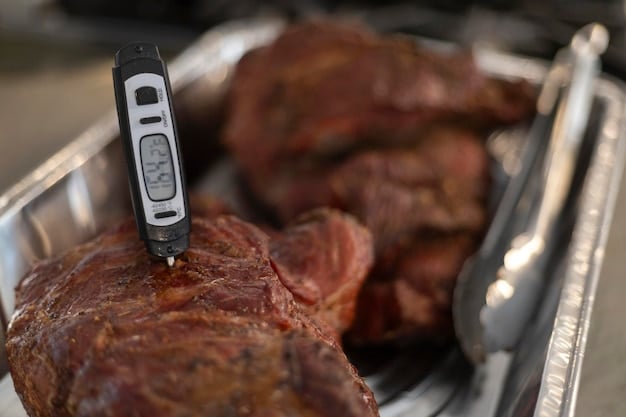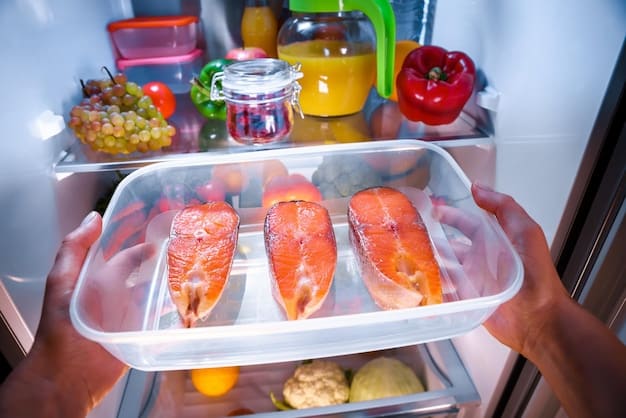Food Safety During Power Outages: A Comprehensive Guide

Food safety during power outages is crucial to prevent foodborne illnesses; keeping food at safe temperatures and knowing when to discard potentially unsafe items are key to protecting yourself and your family.
Losing power can be more than just an inconvenience; it can jeopardize your food safety during power outages. Knowing how to handle food properly when the lights go out is essential to preventing illness and keeping your family safe.
Understanding the Risks of Foodborne Illness During Power Outages
Power outages can compromise the safety of your food, as refrigeration and freezing are critical for preventing the growth of harmful bacteria. When the power goes out, food temperatures rise, creating an environment where bacteria can multiply rapidly, leading to potential foodborne illnesses.
The Danger Zone: Temperature and Bacterial Growth
The “danger zone” for food is between 40°F and 140°F (4°C and 60°C), where bacteria thrive. During a power outage, food can quickly enter this danger zone, making it unsafe to consume if left at room temperature for too long.
Foods at Highest Risk
Certain foods are more prone to bacterial contamination than others. These include:
- Meat, poultry, and seafood
- Dairy products
- Cooked leftovers
- Soft cheeses
- Cut fruits and vegetables
These items should be handled with extra care during a power outage to minimize the risk of foodborne illness.

Understanding these risks is the first step in ensuring food safety during power outages. By recognizing the potential dangers and knowing which foods are most susceptible to contamination, you can take proactive steps to protect yourself and your family from foodborne illnesses.
Preparing for a Power Outage: Stock Up and Plan Ahead
Being prepared for a power outage can significantly reduce the risk of food spoilage and ensure you have safe food options available. Proactive planning and stocking up on essential supplies are key steps to mitigate the impact of power disruptions on food safety.
Essential Supplies to Have on Hand
Before a power outage occurs, gather these essential items to help maintain food safety:
- Thermometers: Refrigerator, freezer, and food thermometers to monitor temperatures.
- Coolers and Ice Packs: To keep perishable foods cold if the power outage lasts longer than expected.
- Non-Perishable Foods: Stock a supply of canned goods, dry goods, and other non-perishable items that don’t require refrigeration.
- Water: Have a supply of bottled water or fill containers with water for drinking and cooking.
Tips for Pre-Outage Food Preservation
Properly preparing your refrigerator and freezer before a potential power outage can prolong the safety of your food:
- Set Refrigerator and Freezer to Coldest Settings: Lower the temperature in advance to keep food colder for a longer period.
- Freeze Containers of Water: These can help keep food cold in the freezer during an outage.
- Group Foods Together: Organize your refrigerator and freezer so that items are close together; this helps them stay colder longer.
By taking these preparatory steps, you can minimize the impact of a power outage on your food supply and increase your ability to maintain food safety.
During the Power Outage: Monitoring and Maintaining Food Safety
Once a power outage occurs, it’s crucial to monitor food temperatures and take steps to keep food as cold as possible. Regular checks and strategic actions can help preserve the safety of your food during this critical time.
Keep Refrigerator and Freezer Doors Closed
One of the most important steps during a power outage is to keep the refrigerator and freezer doors closed as much as possible. This helps maintain the cold temperature inside and slows down the thawing process.
Refrigerator and Freezer Temperature Guidelines
Determining Food Safety
Use a food thermometer to check the temperature of perishable foods in your refrigerator and freezer. If food temperatures rise above 40°F (4°C) in the refrigerator for more than two hours, it may not be safe to consume.
Safe Handling Practices
Following these handling practices will help to ensure safe food practices:
- Consume Perishables First: Eat the most perishable items first to avoid spoilage.
- Use Coolers with Ice: If the power outage lasts longer than four hours, move perishable foods to a cooler with ice or ice packs.
- Discard Questionable Items: When in doubt, throw it out. It’s better to be safe than sorry!

By closely monitoring food temperatures and following these guidelines, you can extend the safety of your food during a power outage. Acting promptly and making informed decisions are key to preventing foodborne illnesses during this time.
After the Power Outage: Assessing and Discarding Food
After a power outage ends, it’s essential to carefully assess the condition of your food before consuming or using it. Discarding potentially unsafe items is crucial to prevent foodborne illnesses and protect your health.
Determining What Food is Safe to Keep
To determine whether food is safe to keep after a power outage, consider the following guidelines:
- Check the Temperature: Use a food thermometer to check the internal temperature of perishable foods. Discard any items that have been above 40°F (4°C) for more than two hours.
- Evaluate the Appearance and Odor: Look for any signs of spoilage, such as unusual color, odor, or texture. If the food appears or smells off, discard it immediately.
- Consider the Duration of the Outage: The longer the power outage, the greater the risk of food spoilage. If the outage lasted more than four hours, exercise extra caution.
Specific Food Guidelines for After a Power Outage
Here’s a guide to help you decide what to keep and what to discard:
- Meat, Poultry, and Seafood: Discard any of these items that have been above 40°F (4°C) for more than two hours.
- Dairy Products: Milk, cheese, yogurt, and other dairy products spoil quickly. Discard if they have been above 40°F (4°C) for more than two hours.
- Cooked Leftovers: Discard any leftovers that have been unrefrigerated for more than two hours.
- Fruits and Vegetables: Discard cut fruits and vegetables that have been at room temperature for more than two hours. Whole fruits and vegetables may be safe if they appear and smell normal.
Freezer Food Safety: Thawed vs. Frozen
If your freezer food remains frozen and feels as cold as if it were in a working freezer, it is generally safe. Partially thawed food can be refrozen if it still contains ice crystals or feels cold. Discard any food that has completely thawed and been at room temperature for more than two hours.
Emergency Cooking and Food Preparation Tips
During and immediately after a power outage, your regular cooking methods may be unavailable. Having alternative strategies for preparing food safely is essential to ensure you can still provide nutritious meals for your family.
Safe Ways to Cook Without Power
When the power is out, consider these alternative cooking methods:
- Outdoor Grill: Use a gas or charcoal grill to cook food outdoors. Be sure to follow safety guidelines for outdoor cooking and keep the grill away from your home.
- Camping Stove: If you have a camping stove, you can use it to heat water and cook simple meals.
- Canned Foods: Rely on canned foods that can be eaten cold without cooking.
Food Safety Considerations for Emergency Cooking
Remember these food safety considerations:
- Use Safe Water: If your tap water isn’t safe to drink, use bottled water or boil water before cooking.
- Cook Food Thoroughly: Ensure food is cooked to a safe internal temperature to kill harmful bacteria.
- Practice Good Hygiene: Wash your hands thoroughly before preparing any food.
By utilizing these emergency cooking methods and following strict food safety practices, you can provide your family with safe and nutritious meals during and after a power outage.
Resources and Further Information on Food Safety
Staying informed about food safety is crucial for protecting yourself and your family from foodborne illnesses, especially during emergencies like power outages. Utilize the available resources that offer valuable insights and guidance.
Government and Nongovernmental Resources
Here are some resources that can help you stay informed:
- FDA (Food and Drug Administration): Provides information, regulations, and guidelines on food safety in the United States.
- USDA (U.S. Department of Agriculture): Offers resources related to food safety, nutrition, and public health.
- CDC (Centers for Disease Control and Prevention): Provides data and recommendations for preventing foodborne illnesses.
Local Health Department Contact Information
Contact information and guides specific to your region may be available here:
- Contacting Local Health Department: Your local health department can offer guidance specific to your community.
Taking the time to gather information and utilize these resources can empower you to make informed decisions and take proactive steps to protect your family’s food safety.
| Key Point | Brief Description |
|---|---|
| 🌡️ Temperature Monitoring | Regularly check food temperatures to ensure they stay below 40°F (4°C) during an outage. |
| ❄️ Keeping Doors Closed | Minimize opening refrigerator and freezer doors to maintain cold temperatures longer. |
| 🗑️ Discard When in Doubt | If you’re unsure about the safety of a food item, discard it to prevent foodborne illness. |
| 🧊 Use Coolers | Keep perishable foods in coolers with ice packs if the power outage lasts longer than 4 hours. |
Frequently Asked Questions
▼
A refrigerator will keep food safe for up to 4 hours during a power outage, provided the door remains closed. Discard any perishable foods that have been above 40°F (4°C) for more than 2 hours.
▼
If the food still contains ice crystals or feels cold, it can be refrozen. However, discard any food that has completely thawed and been at room temperature (above 40°F) for more than 2 hours.
▼
Discard meat, poultry, seafood, dairy products, cooked leftovers, and soft cheeses that have been above 40°F (4°C) for more than 2 hours. When in doubt, throw it out.
▼
Use coolers with ice or ice packs to keep perishable foods cold. Group foods together, keep the cooler in a cool place, and minimize opening the cooler to maintain a lower temperature.
▼
Tap water is generally safe unless your local authorities issue a warning. If in doubt, use bottled water or boil tap water before drinking to kill any potential bacteria.
Conclusion
Ensuring food safety during power outages is essential for protecting your health and preventing foodborne illnesses. By preparing in advance, monitoring food temperatures, and following safe handling practices, you can minimize the risks associated with power disruptions. When in doubt, discard any questionable items to safeguard your well-being and that of your family.





